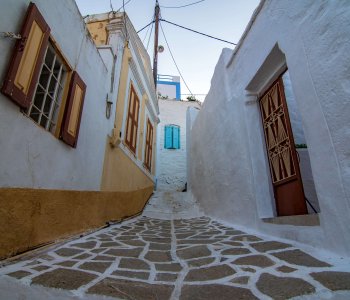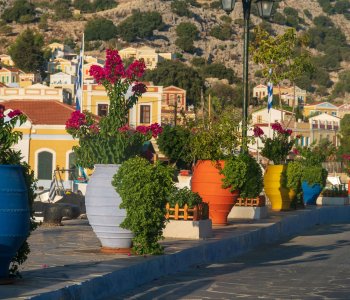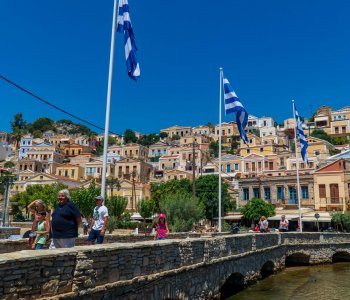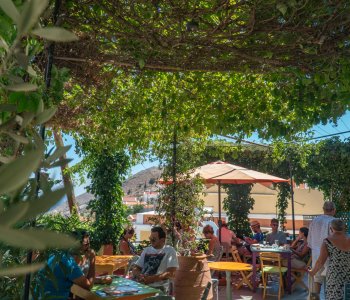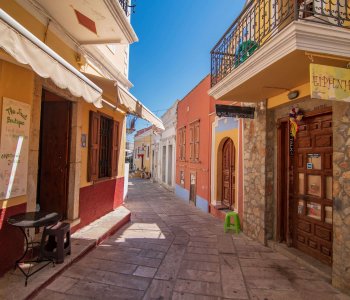Things to see in Symi
Symi island is one of the most beautiful and unique islands combining the natural beauty with small architectural touches that will leave you in awe.
There are many things to see and places to visit in Symi and we have collected the best sightseeing options of the island for your ease.
From the several crystal clear beaches of Symi island, to the many unique neighborhoods with the colorful traditional houses, to the great mountain view and wineries there are several things to see in Symi, most of you can explore in a day cruise which can be easily arranged.
When arriving from Rhodes, the first thing to see in Symi will be the harbor and colorful houses that welcome you along with the crystal sea waters.
From there you can explore at your ease and enjoy your visit to Symi to the fullest.
Read below our suggestions and the history behind them.
Gialos

In the 19th century and until the beginning of the 20 th century, the island had about 25 thousand inhabitants; it was a fishing and spong e center. In the shipyards of the island around 500 sailing ships were built each year. Today, the hospitable people approach the three thousand, and in recent years, most of them are engaged in tourism. As soon as the ship from Rhodes approaches the harbor, we see the unique architecture with colorful houses reminiscent of a movi e set. The characteristic of the port is the clock tower, gift of the Petrides family of 1881, is the first thing we see and behind the building where the police and the post of fice are housed, the only building on the island that reminds of the Italian period. In front of the police is the bust of the politician Giorgos Gennimatas, who came from Symi.
If you go to the right of the clock tower, you will find Harrani, the shipyard with t wo or three of the last shipbuilding masters of the Aegean Sea. Just below a narrow lane with steps leads to the hill where the church of Panagia Evangelistria is located, a point with a beautiful view. If we continue along the road near the sea, we w ill soon reach the NOS beach, unique in Yialos and from there the way to Nimborio. We return to the Clock Tower to move towards the center of the harbor and on the right is the three-storied Kampsopoulou Villa, where t he Germans signed the capitulation of the Dodecanese Islands to the Allies , who used this house as their headquarters. Evidence of the event the inscriptions on the front of the building, one in Greek and the other in English.
A little further is carved on a rock, a copy of the relief from the Lindos Acropolis and an inscription wi th a stanza from a poem that speaks of freedom. In front of the rock the Dove of Pea ce, work of the sculptor from Symi, Costas Valsamis. We approach the center of Gial os and meet the stone bridge Kantirimi, which connects the two sides of the port . Immediately afterward there is the customs office and the old open fish market. From the bridge on the right is the place where the oldest shipyard on the island was.
Af ter the Second World War, the trees were cut off, and the first desalination plant o f the island was built here. Today, various artistic events take place on this square. Fu rther in, we find the town hall of Symi and the Marine Museum. Still further are the kind ergarten and then the elementary school. To the left of the school, we de scend a few steps that lead us to the beautiful cobbled courtyard of the Church of St. John, the Episcopal church of the island, with its impressive bell tower. After passing by the offices of the Episcopal seat, a narrow lane leads back to the harbour, at the point where the boats that go to the beaches start their day trips. We leave the port, and in front of the pharmacy we enter the narrow streets and reach the Skala Square.
Horio
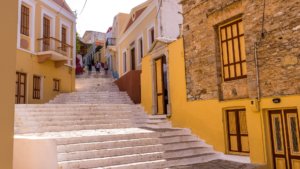
From here begins the famous path, Kali Strata (main st aircase) with 500 steps up to Horio or Ano Symi, a place that, was built far from th e sea for fear of the pirates, like most of the old capitals of the islands. After about 400 steps and after the mansions that remind of the time of the great prosperity of th e island, we arrive at the quiet Syllogos Square, where some restaurants and cafes are lo cated around. Turn left, and you will reach Pontikokastro with its 20 old windmil ls, where once the wheat was ground for the bread and the seamen rusks. If we contin ue straight from the square, we will meet the old municipal pharmacy of the isla nd or Spetsaria with the same interior since the 19th century.
A little further down is the house of Petinakis, a typical example of local architecture. If we follow the small signs to the archeological museum, we will find the four-storey villa Chatziagap itou with its famous hall. The Archaeological Museum, which we reach after that, is l ocated in the house of Nikolaos Farmakidis. In the village there are several c hurches, including Panagia Charitomeni and the great Panagia tou Kastrou (Maria of the Castle), where, if you are lucky and find someone to open the church, and of course the icon is not in an exhibition, you will See “The Last Judgment” from th e 16th century, a masterpiece of the great painter Georgios Klontzas.
When we arrive at the top except the St. Mary’s Church , we will see the Knight’s Castle, built in the early 14th century, on the site of the ancient Acropolis. The coats of arms of the Grand Masters on the walls bear witness to who participated in the works of the time. From here, the view of the village, Gialos, and Pedi is unique.
Pedi
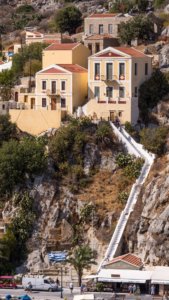
From Horio, we do not go back to Gialos, but to Pedi , a beautiful bay where the Symiots used to have their summer cottages to spend t he summer. Today in Pedi there is a hotel with the biggest number of beds on the is land but also rooms or houses for rent. The municipality of Symi also plans to build a marina for sailboats and yachts. There are many orchards, olive trees, almond trees and pr ickly pears in the area. On the way to Pedi, we meet the church Panagia Alithini , where every summer a big festivity is celebrated. Somewhat below is the power plant, which supplies the island with electricity. One of the most important but sti ll unknown places of Symi lies between Horio and Pedi; it’s the petrified forest, one of the few in Greece.
Nimporio
From the clock tower of the port of Gialos, we turn right and pass the NOS beach. We arrive at the port of Nimporio, which has become a sm all settlement today. It was called Emporion (Emp ȯ rio = trade) because it was an important trading cent er. The archaeological findings are significant, such as the supernatural (about three meters) marble statue of a boar, which is now in Istanbul, a s well as the “funeral stele of Simi” Ionian work of 520 BC. A man with robe and spear, almo st life-size is depicted. There are also altars by Apollo and the Muse Urania. The ruins of an early Christian basilica near the sea are located below the chapel of St. Eirini.
In a later time, three chapels were built, repla cing the basilica. In the same area one also found vaulted underground rooms, the Dodeka Spilia (twelve caves), which were probably used as painting and sculpture workshops , while according to other, they were ancient tombs. With the construction of the road leading to Nimborio , the tourist development of the area began.
Byzantine wine presses
On the way from Gialos to Panormitis, one of the mona steries we encounter is that of the Great Sotiris. There we see the sign that leads t o the left, indicating the small path to the Kourkouniotis area in the cypress forest. Here a re the eleven restored Byzantine wine presses, a total of 120 to the 18th century exca vated on the island and most of them were found in this area. They were used to make t he famous white wine of Symi, which was very popular with foreign travelers.

